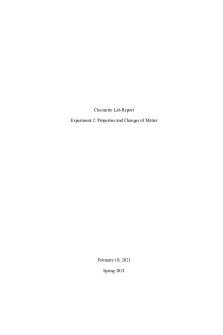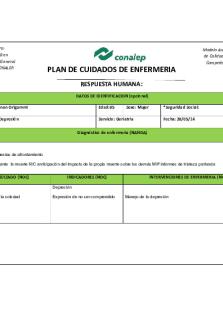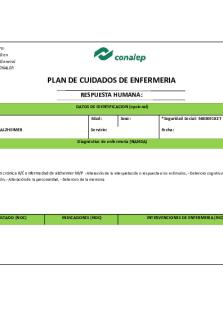Spinal cord gray matter integrates information and initiates commands, and white matter carries information from place to place PDF

| Title | Spinal cord gray matter integrates information and initiates commands, and white matter carries information from place to place |
|---|---|
| Course | Human Anatomy and Physiology with Lab I |
| Institution | The University of Texas at Dallas |
| Pages | 2 |
| File Size | 53.5 KB |
| File Type | |
| Total Downloads | 13 |
| Total Views | 122 |
Summary
Spinal cord gray matter integrates information and initiates commands, and white matter carries information from place to place...
Description
Spinal cord gray matter integrates information and initiates commands, and white matter carries information from place to place We have seen that the patterns of gray and white matter found in cross sections of the spinal cord vary with the spinal cord regions (see Figure 13–2c). Recall that in nervous tissue gray matter is dominated by the cell bodies of neurons, neuroglia, and unmyelinated axons, while the white matter contains large numbers of myelinated and unmyelinated axons. In this section we relate this cross-sectional organization to the functional organization of both gray and white matter in the spinal cord (Figure 13–5). Functional Organization of Gray Matter The left side of Figure 13–5a shows the structural pattern of gray matter in the spinal cord. In cross section, this gray matter forms an H, or butterfly, shape and surrounds the narrow central canal. The areas of gray matter on each side of the spinal cord (to the left or right halves defined by the anterior median fissure and posterior median sulcus) are called horns. There are posterior, lateral, and anterior horns, depending on their positions (Figure 13–5b). The narrow bridges of gray matter posterior and anterior to the central canal are gray commissures (commissura, a joining together). Now let’s think about what this organization of gray matter can tell us about its function. Masses of gray matter within the CNS are called nuclei; there are both sensory and motor nuclei. Sensory nuclei receive and relay sensory information from peripheral receptors. Motor nuclei issue motor commands to peripheral effectors. These motor and sensory nuclei are organized together in the spinal cord. If you took a frontal section along the length of the central canal of the spinal cord, it would separate the sensory (posterior, or dorsal) nuclei from the motor (anterior, or ventral) nuclei. The posterior horns contain somatic and visceral sensory nuclei, and the anterior horns contain somatic motor nuclei. The lateral horns, located only in the thoracic and lumbar segments, contain visceral motor nuclei. The gray commissures contain axons that cross from one side of the cord to the other before they reach an area in the gray matter. The right side of Figure 13–5a shows the relationship between the function of a particular nucleus (sensory or motor) and its position in the gray matter of the spinal cord. Although sensory and motor nuclei appear small in transverse section, nuclei are also spatially organized—they may extend for a considerable distance along the length of the spinal cord. In the cervical enlargement, for example, the anterior horns contain nuclei whose motor neurons control the muscles of the upper limbs. On each side of the spinal cord, in medial to lateral sequence, are somatic motor nuclei that control (1) muscles that position the pectoral girdle, (2) muscles that move the arm, (3) muscles that move the forearm and hand, and (4) muscles that move the hand and fingers. Within each of these regions, the motor neurons that control flexor muscles are grouped separately from those that control extensor muscles. Because the spinal
cord is so highly organized, we can predict which muscles will be affected by damage to a specific area of gray matter....
Similar Free PDFs

ANS and Spinal Cord Labeling
- 3 Pages

Spinal Cord and Lower Brain
- 5 Pages

Lesson 1 Energy and Matter
- 1 Pages

Time and place of contract
- 16 Pages

Chapter 3 Matter and Energy
- 8 Pages

Tuan Space and Place and Time
- 7 Pages

CH.1 Matter and Measurement
- 4 Pages

Light Waves and Matter Worksheet
- 2 Pages

Properties and Changes of Matter
- 18 Pages

History OF Matter AND Atoms
- 2 Pages

Chapter 3 Matter and Energy
- 5 Pages

Depresion - PLACE
- 3 Pages

Asma - PLACE
- 2 Pages

Alzheimer - PLACE
- 4 Pages
Popular Institutions
- Tinajero National High School - Annex
- Politeknik Caltex Riau
- Yokohama City University
- SGT University
- University of Al-Qadisiyah
- Divine Word College of Vigan
- Techniek College Rotterdam
- Universidade de Santiago
- Universiti Teknologi MARA Cawangan Johor Kampus Pasir Gudang
- Poltekkes Kemenkes Yogyakarta
- Baguio City National High School
- Colegio san marcos
- preparatoria uno
- Centro de Bachillerato Tecnológico Industrial y de Servicios No. 107
- Dalian Maritime University
- Quang Trung Secondary School
- Colegio Tecnológico en Informática
- Corporación Regional de Educación Superior
- Grupo CEDVA
- Dar Al Uloom University
- Centro de Estudios Preuniversitarios de la Universidad Nacional de Ingeniería
- 上智大学
- Aakash International School, Nuna Majara
- San Felipe Neri Catholic School
- Kang Chiao International School - New Taipei City
- Misamis Occidental National High School
- Institución Educativa Escuela Normal Juan Ladrilleros
- Kolehiyo ng Pantukan
- Batanes State College
- Instituto Continental
- Sekolah Menengah Kejuruan Kesehatan Kaltara (Tarakan)
- Colegio de La Inmaculada Concepcion - Cebu

